Haystack Observatory
An interdisciplinary research center located in Westford, Massachusetts, some 40 miles northwest of the MIT campus, Haystack Observatory conducts astronomical studies using radio techniques, geodetic measurements using Very Long Baseline Interferometry (VLBI), and atmospheric observations using high power incoherent scatter radar. The current priority of the radio astronomy program at Haystack is the development of large arrays of telescopes that will achieve high sensitivity and resolution needed for the study of the structure of our galaxy, the early universe, and transient astronomical events. The astronomy research program is carried out under the auspices of the Northeast Radio Observatory Corporation (NEROC), a consortium of eleven educational and research institutions in the northeast. The primary objective of the geodetic research is to improve the accuracy of measurements of earth's orientation parameters by enhancing the bandwidth of the observations through innovative instrumentation development. The current goal of the atmospheric science program is to understand the impact of solar disturbances on the earth's upper atmosphere. An important component of the observatory's mission is to support the training of students by providing opportunities for them to link their education with research through the disciplines practiced at the observatory. The observatory receives financial support primarily from federal agencies including the National Science Foundation (NSF), the National Aeronautical and Space Administration (NASA), and the Department of Defense, as well as from industrial sources.
Instrumentation
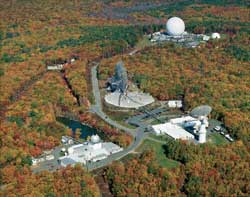 |
The Haystack Observatory instrumentation consists of the following facilities:
- A 37-m diameter radio telescope used for astronomical observations and for radar measurements.
- An 18-m diameter radio telescope involved in VLBI measurements of the earth's rotation parameters.
- An 8-station wideband VLBI correlator used to process global geodetic and astronomical observations.
- A 2.5 MW UHF radar that utilizes two large antennas, 46m and 67m in diameter, to study the earth's upper atmosphere using incoherent backscatter techniques, augmented by passive optical telescopes.
Radio Astronomy
Haystack Observatory has successfully initiated two major new projects that have redefined the observatory's research mission in radio astronomy. The projects involve the development of radio arrays at low frequencies that will yield major enhancements in sensitivity and resolution for astronomical studies.
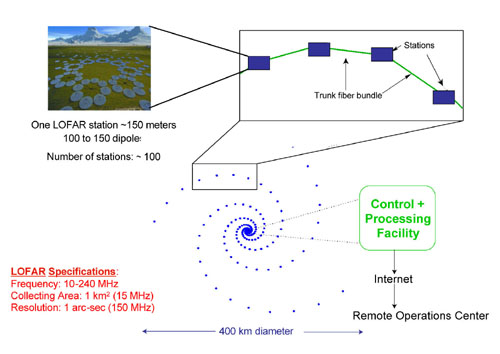 Low Frequency Array stations and system configuration. |
The first project is the Low Frequency Array (LOFAR) that will operate in the 10-240 MHz frequency range using 100 stations distributed over 400 km and connected with optical fiber. LOFAR will allow the detection of radio sources at the milli-Jansky level with arc-second resolution, and will be the first fully digital radio telescope capable of observing with multiple independent beams. The project is led at Haystack by Dr. Colin Lonsdale, and collaborators include Dr. Roger Cappallo and Dr. Sheperd Doeleman, and Professor Jacqueline Hewitt of the MIT Physics Department. The scientific projects of interest to the MIT and Haystack astronomers involve measurements of the structure of the universe at the early epoch of re-ionization and detection of astronomical transients such as gamma ray bursts through their radio emission. Under a grant received in the past year from the National Science Foundation-Information Technology Research program, the overall array configuration and system specifications have been formulated. Substantial progress has also been achieved in the development of a performance simulator that is used to assess the various design options and the effectiveness of the calibration system for the array. Specifications for the transient detector and identification of the algorithms needed to process the observations have been outlined. In addition, Haystack has initiated the design of the LOFAR antenna covering the upper frequency band (110–240 MHz).
LOFAR is a collaborative effort that includes in addition to MIT, the Naval Research Laboratory (NRL) and the Netherlands Foundation for Radio Astronomy (ASTRON). During the past year, a letter of understanding that outlined the terms of the joint development was signed by all three partners. The program management has been established and includes a science consortium board and an engineering consortium group. A kick off meeting for the project was held at Haystack in mid October 2001 and was attended by a large number of researchers from the US and European astronomical communities. This served to introduce the scientific opportunities that will be available with LOFAR for low frequency astronomy and for ionospheric and solar studies and to motivate interest and collaborations. A key long term objective is to establish a science center at Haystack to operate LOFAR and facilitate access to it by the US astronomy community. The schedule for completing the LOFAR design is early 2004. Construction would follow, leading to an initial operating capability in 2006 and a final operating system in 2008. Three candidate LOFAR sites are currently being evaluated: the southwest US, the Netherlands, and western Australia. The plan is to make a site selection by the time of the preliminary design review in early 2003.
Closely related to the LOFAR project is another large radio telescope—the Square Kilometer Array (SKA). This array will operate at frequencies from 300 MHz to possibly 35 GHz, and will consist of about 1000 stations, thus extending LOFAR's capabilities to higher frequencies and broadening the scientific potential. Examination of various concepts to achieve the SKA goals are being pursued by a large international consortium of astronomical institutions, and key technology investigations are being initiated in various countries with the expectation that detailed design and construction would start early in the next decade. The US contributions to the SKA development are being coordinated by a US consortium that includes MIT and Haystack. Through a proposal submitted by the consortium and led by Cornell University, Haystack has been recently funded to undertake simulation studies to determine the most effective array configuration. Haystack plans to maintain a strong involvement in the SKA project and to build further on the research capabilities developed for LOFAR.
The second major new project at Haystack is the development of a multibeam array at 327 MHz for the detection of deuterium—a most sensitive indicator of the density of baryons that relates to the amount of dark matter in the universe. Detection of the deuterium line at its radio frequency has been elusive due to the inadequate sensitivity of available telescopes. Haystack's proposed approach is through the design of a sensitive digital receiver for a 32-station array of dipole elements with dual polarization that will be constructed at the observatory in Westford. The project is led by Dr. Alan Rogers and is funded by the NSF Major Research Instrumentation program, with cost-sharing support from TruePosition, Inc., which supports research at Haystack on the radio location of E911 calls from cellular phones. Prototyping of the antenna and receiver have progressed well during the past year, and a major effort has been expended on characterizing the radio frequency interference environment at 327 MHz around the MIT site in Westford. Following tests of the prototype system, construction is expected to start in 2003 and astronomical operations to detect the deuterium line will occur in 2004.
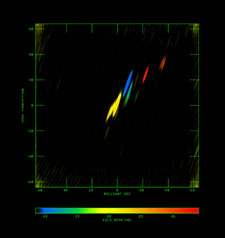 Map of SiO maser emission at 129 GHz for the star CYVMa. |
Other astronomical research work by Haystack staff continues through the conduct of VLBI experiments at millimeter wavelengths using a global array of twelve radio telescopes. The most significant scientific result that has emerged from this research in the past year has been the first detection of interferometric fringes on a radio source at 129 GHz. The experiment was led by Dr. Shep Doeleman of Haystack using two millimeter-wave radio telescopes in Arizona—one on Kitt Peak and the other on Mt. Graham. The IRAM telescope in Spain also participated through collaboration with the Max Planck Institute in Bonn, and the resulting fringes on this long baseline set a new record for angular resolution at ~50 micro arcseconds. A map of the silicon monoxide maser emission towards the evolved star VYCMa revealed features that suggest the presence of a stellar disk with a gas outflow resulting in a nebula which has been known to exist in this star from optical observations. It is Haystack's intent to concentrate in the future on VLBI observations at wavelengths less than 3 millimeters, since these offer both technical challenges and exciting potential for scientific discovery. In order to support these new studies, a collaboration with the University of Arizona has been established, and a proposal has been submitted jointly to the NSF. With this new emphasis, routine VLBI operations at 3 millimeter wavelength is being transferred in 2003 to the National Radio Astronomy Observatory in Socorro, New Mexico, as part of operations of the Very Long Baseline Array.
Instrumentation Development
Haystack's instrumentation development program is focused on high data rate recording and on efficient transfer of wideband data from telescopes participating in geodetic and astronomical VLBI experiments to the central processors or "correlators." Under the leadership of Dr. Alan Whitney, the Mark 5 data system is being designed to operate at a recording rate of 1 Gbit/sec, utilizing commercial off the shelf components based on magnetic disks. The Mark 5 will replace the aging tape recorders that are expensive to maintain and have limited bandwidth and growth capability. The Haystack development work is supported by funding partners from the national and international astronomy and geodesy communities, and involves an industrial firm, Conduant Corporation of Colorado, which is supporting Haystack's project. The past year's work has resulted in the completion of prototype systems that have been placed at radio telescopes in Westford, Hawaii, and Germany for initial tests. Successful completion of these tests led to further production of beta units that are now being distributed to all participating partners in order to acquire operational experience with these new systems. The Mark 5 data systems will then be upgraded based on the feedback received, and the design will be transferred to industry for full implementation worldwide.
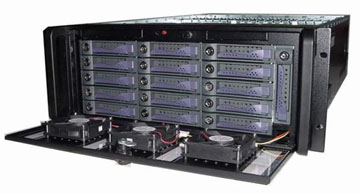 Mark 5 data system with magnetic disks. |
As part of the Mark 5 system development, the necessary interfaces for radio telescopes are being designed so that data can be eventually transferred using high speed wideband communication links. With the rapid expansion of fiber optic links across the US, Europe and Japan, real time transmission of VLBI data from the radio telescopes to the correlator has become feasible. The advantages of real time data transmission include the further expansion of bandwidth beyond that allowed through data recording, as well as the ability to test experimental setups in the field through prompt verification of initial data acquisition and reduce processing delays. Dr. Whitney's team has initiated tests of real time VLBI data transmission, dubbed 'e-VLBI', using the new fiber optic link installed by Lincoln Laboratory to connect Haystack with the laboratory in Lexington and the MIT campus, as well as DARPA's Bossnet system that connects the fiber to the Washington DC area. With seed support from DARPA and NASA, data transmission at near 1 Gbit/s was successfully tested during the past year, and now the observatory's 60-m telescope in Westford is being linked through the fiber network to a 10-m telescope at Goddard Space Flight Center in Maryland. Data from both telescopes will be transmitted to the Haystack Mark 4 correlator to demonstrate the capabilities and advantages of real-time processing.
A workshop on connecting the global array of radio telescopes with high speed networks was convened at Haystack in April 2002 and was attended by about 80 astronomers and network experts from the national and international community in the US, Europe and Japan. Much enthusiasm was expressed for linking the telescopes through wideband fibers and for solving the "last mile" problem of connecting telescopes that are generally located away from population centers to avoid frequency interference. Plans for insuring compatibility of interface equipment amongst the telescopes were also formulated. Motivated by this enthusiasm, Haystack Observatory prepared and submitted a proposal to the NSF Division of Computer and Information Sciences Directorate, in collaboration with the MIT Laboratory for Computer Sciences (LCS) and the Lincoln Laboratory, to develop and test the necessary protocols for sharing the available commercial bandwidth on internet fibers. The project led by Dr. Whitney of Haystack and Dr. John Wroclawski of LCS has been approved and will form the focus of our research work in this area for the next few years while the fibers are being installed at various telescopes worldwide in order to connect them to the global grid.
Finally, in a project led by Dr. Alan Rogers and supported by TruePosition, Inc., Haystack has recently supported a critical field test of a network system that locates E911 calls from cellular phones, using VLBI time delay measurement techniques. The test, conducted in Houston using Cingular's cellular network, successfully demonstrated the accuracy of the system to locate such calls well within the specifications set by the FCC. This success will now allow full implementation of the location system on Cingular's network. Current plans call for further research on future digital cellular phone systems and on the use of angle of arrival measurements to support radio location in rural areas. Haystack Observatory plans to continue its technical consulting role for TruePosition with emphasis on the challenging new digital systems to be deployed in the future.
Atmospheric Science
The primary focus of the atmospheric science research at Haystack Observatory continues to be placed on the study of the effects of solar disturbances on the Earth's upper atmosphere and ionosphere. The disturbances cause large geomagnetic storms that produce severe gradients in ionospheric density and scintillations in radio signals caused by small scale structures and turbulence in the upper atmosphere. Such effects of "space weather" have a deleterious impact on communication satellites and on navigation systems that rely on the Global Positioning System (GPS). The observatory's atmospheric sciences group led by Dr. John Foster has studied space weather effects on Earth's middle latitudes using both the Millstone Hill radar and ground based GPS receivers, in combination with NASA's and DoD's fleet of satellites stationed in the solar wind and in earth's magnetosphere. In collaboration with scientists at Rice University, Lincoln Laboratory, and the Air Force Research Laboratory, the studies have revealed that during geomagnetic storms, enhanced electron densities result from the erosion of the outer plasmasphere by penetration electric fields. Plumes of enhanced density in earth's ionosphere as seen with the GPS network and the observatory's incoherent scatter radar at sub-auroral latitudes map directly into the plasmaspheric tails that are imaged by satellites such as NASA's IMAGE spacecraft. Such a coupling between the magnetosphere and ionosphere serves to clarify the relationship between these two regions and the role of the plasmaspheric tails that develop during magnetic storms in modifying earth's ionosphere.
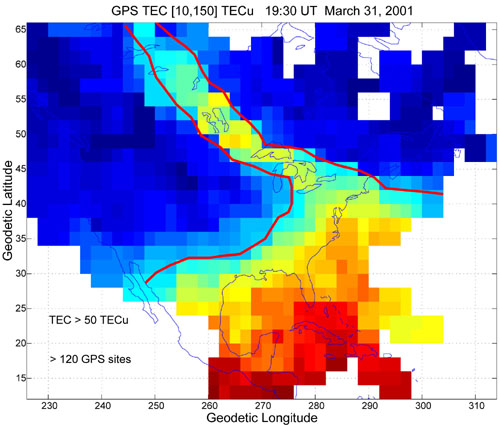 Map of total ionospheric electron content over North America derived from GPS data during a geomagnetic storm. |
Another major area of research in the atmospheric sciences group involves the study of perturbations due to geomagnetic storms on Earth's neutral atmosphere at altitudes above 80 km—in the mesosphere and thermosphere layers. The study uses a combination of data from the global network of incoherent scatter radars including the observatory's Millstone Hill radar and from NASA's TIMED satellite that was successfully launched in December 2001. Led by Dr. Joseph Salah and staff in the atmospheric sciences group, in collaboration with an international team of scientists, the project has successfully captured the effects of a major geomagnetic storm that occurred on 17-19 April 2002. The storm resulted in large enhancements of neutral winds up to 500 m/s at 120 km and electric fields as large as 100 mV/m in the ionosphere, compared to 50 m/s and 1-2 mV/m during quiet conditions. Detailed analysis of the radar and satellite data is now proceeding, and several workshops have been organized to interpret the measurements for one of the best-documented storms to be observed in a coordinated "alert mode" campaign using a vast array of satellites and ground-based radars.
Statistical models of the earth's ionosphere are being developed by Dr. John Holt and collaborators using the large database of ionospheric observations collected with the Millstone Hill incoherent scatter radar since 1961. Emphasis in this modeling effort is on delineating the effects of solar flux, seasonal, and geomagnetic index dependencies, and representing the daily variations of electron density, temperature, plasma and neutral motions at various altitudes with analytical expressions. Because of the large data set, such variations can now be reliably determined and long-term trends can be derived from the observations. The models have been produced in terms of "movies" that provide an excellent visualization of the variations, and these will be used in verifying the results obtained from theoretical models based on first principles such as the solution of the coupled momentum, energy and continuity equations. The statistical models are made freely available to the community at large through the web, and can be exercised with a user friendly method to specify the entry parameters. The next phase of the project is to expand the model to more global coverage by including radar observations from other locations.
Educational Programs
Opportunities for education and research in radio astronomy at the undergraduate level using the MIT facilities at Haystack continue to be provided and expanded successfully under the leadership of Dr. Preethi Pratap, the observatory's educational officer. The primary component of the educational program has been the development of a small radio telescope (SRT) kit that can be assembled and used by students for observations. The kit, consisting of a steerable 2-m antenna and a 1.4 GHz receiver, has now been successfully commercialized and a total of 70 SRTs have so far been distributed to various colleges and universities in the US and overseas. The SRT has been upgraded with a digital receiver that allows more sensitive observations to be made, a noise source calibrator has been added, and the feasibility of radio interferometry using two SRTs has been demonstrated during the past year. The educational research projects using the SRT, such as monitoring the solar flux and detecting flares, continue to be developed and placed on the observatory's educational web site so that they can be shared widely with the community. Evaluation of the effectiveness of the SRT as a research learning tool has indicated that many of the colleges have successfully integrated the SRT and its projects into their undergraduate courses and laboratory activities, thus providing an important hands-on element for introducing research and observational techniques to students. Our future plans involve the connection of two or more SRTs in the field to teach the principles of radio interferometry and allow high-resolution measurements of features on the sun.
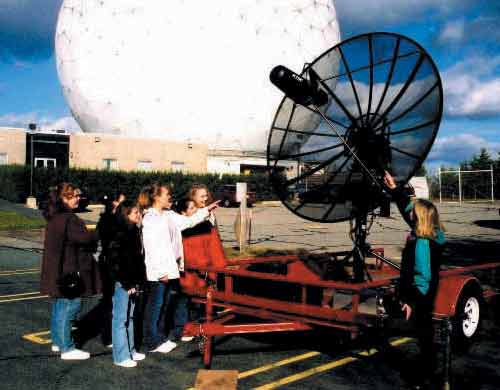 Haystacks's small radio telecope mounted on a trailer for various outreach activities. |
In addition, the observatory's 37-m telescope continues to be used by students for research projects that require higher sensitivity than that of the SRT and require observations at frequencies above 1.4 GHz. A total of 220 students from 23 colleges within the NEROC consortium and elsewhere have utilized the observatory's 37-m telescope during the past year, by either visiting Haystack or controlling the telescope remotely through the internet. Projects included the search for methanol masers in the Milky Way galaxy which are signposts for regions of star formation, mapping the structure of gas clouds using the ammonia line, and monitoring of emission from water vapor masers. To help introduce faculty from small colleges to radio astronomy techniques and to the educational facilities at Haystack, a short course under the NSF Chautauqua series is offered annually at the observatory and is attended by 15-20 faculty members. Training on the use of the 37-m telescope and the SRT kit are included in this course, and has been found to be an effective way to disseminate the information widely.
Haystack's Research Experiences for Undergraduates (REU) program has been extended by the NSF for another five years. Its purpose is to provide summer research internships for undergraduate students, thus strengthening their education through research. The students are recruited nationally and are mentored by MIT staff at Haystack as they work on various observatory projects. Outreach to pre-college teachers has continued through the Research Experiences for Teachers (RET) program, which provides internships to local area science teachers. The teachers develop lesson plans based on what they learn at Haystack and use them in their science classes.
More information about the Haystack Observatory research and education programs can be found on the web at http://www.haystack.mit.edu/.